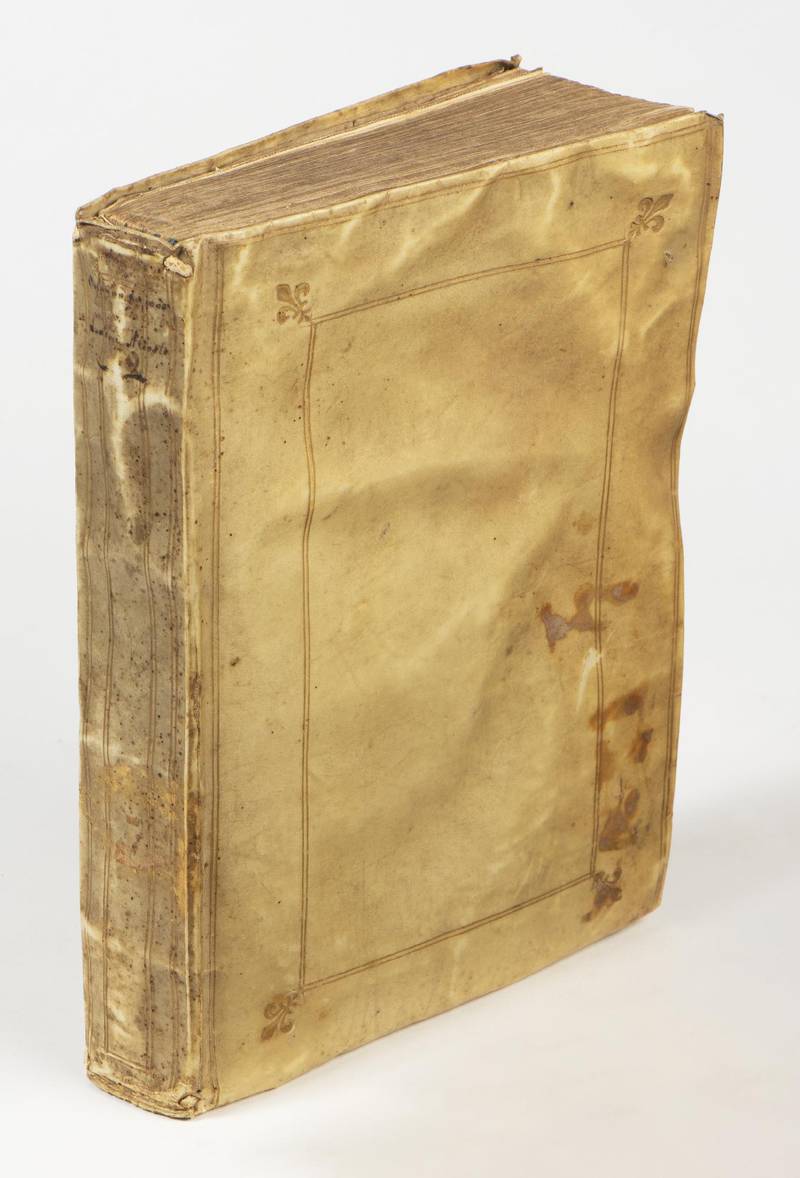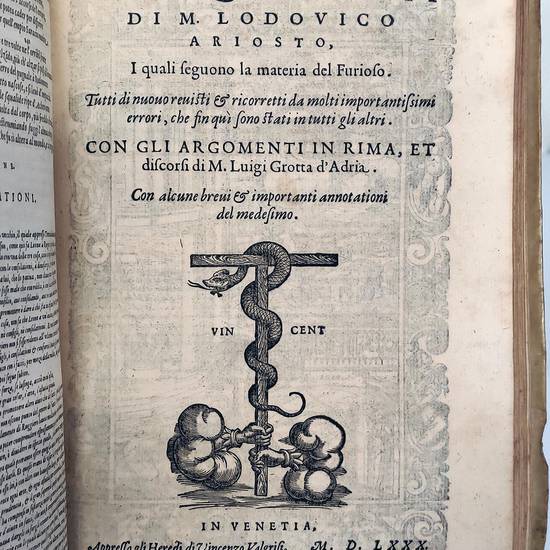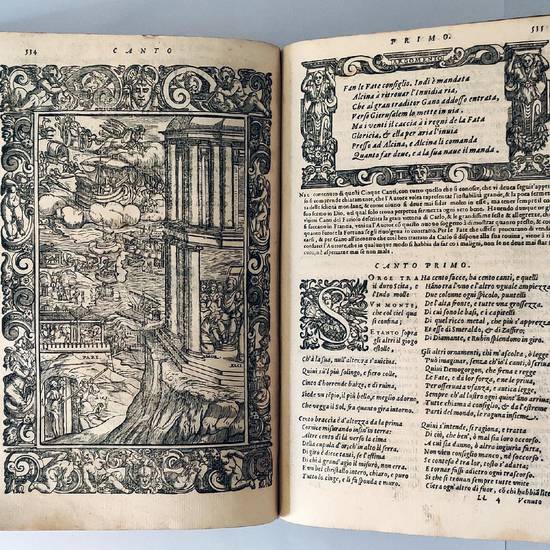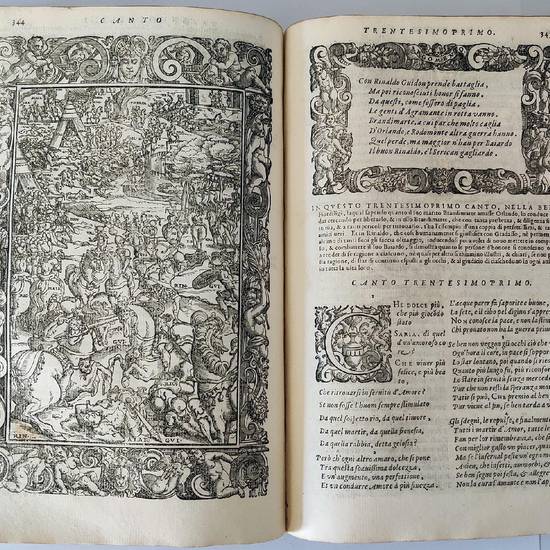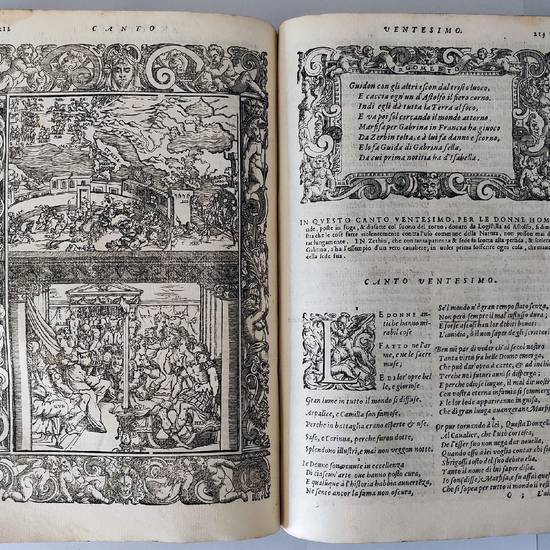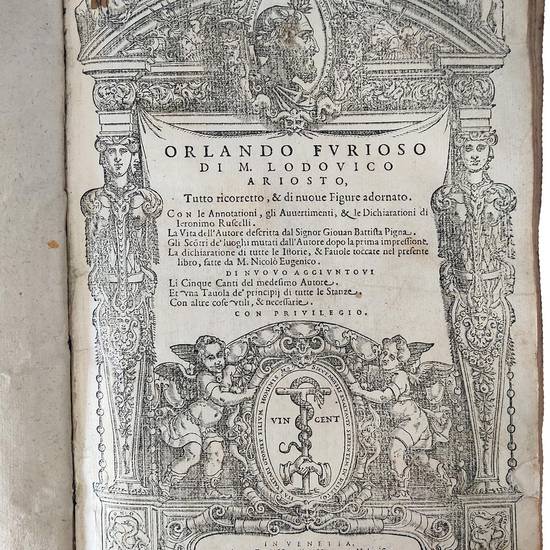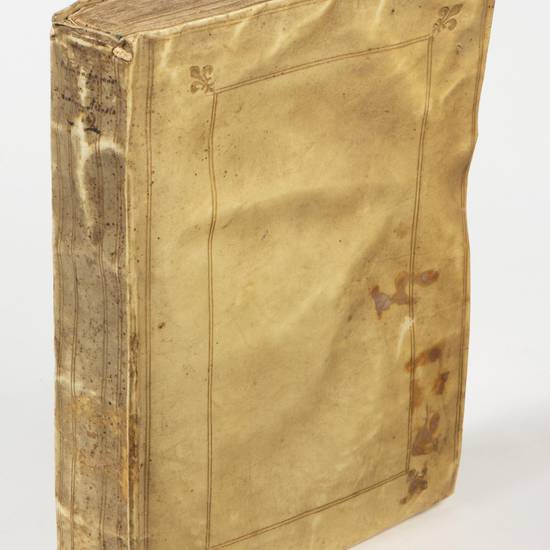Orlando furioso di M. Lodovico Ariosto, tutto ricorretto, & di nuove figure adornato. Con le annotationi, gli avvertimenti, & le dichiarationi di Ieronimo Ruscelli. La vita dell'Autore descritta dal signor Giovan Battista Pigna. Gli scontri de' luoghi mutati dall'Autore dopo la prima impressione. La dichiaratione di tutte le istorie, & favole toccate nel presente libro, fatte da M. Nicolò Eugenico. Di nuouo aggiuntovi li Cinque canti del medesimo autore. Et una tavola de' principij di tutte le stanze. Con altre cose utili, & necessarie
Autore: ARIOSTO, Ludovico (1474-1533)-RUSCELLI, Girolamo ed. (1504-1566)
Tipografo: eredi di Vincenzo Valgrisi
Dati tipografici: Venezia, 1580
4to (248x180 mm). [16], 654, [32] pp. Collation: *8 A-Z8 AA-VV8. Lacking the last blank leaf VV8. Title page within an elaborate woodcut border incorporating Ariosto's portrait on top and Valgrisi's device at the bottom. With 51 full-page woodcut illustrations in text at the beginning of each Canto. Woodcut headpieces, initials and frames. The Cinque canti begins at l. LL3r (p. 533) with a separate title page bearing a large Valgrisi's device. Nicely bound in contemporary gilt vellum, inked title on spine, double concentric frame with fleur-de-lys corner pieces both on the panels and on the spine, gilt edges (lacking ties, some stains on the front cover, two small rips on the back panel). On the first front flyleaf ownership's inscription “E. Wallmoden Vienna 1786 3 fl”; on the second front flyleaf another manuscript entry “2 rm 8 ggr Joseph Rosenkranz Göttingen 1824”. Gutter and lower margin of a few leaves in the first and last quire reinforced, small loss to the outer margin of the title page slightly affecting the border, some quires a bit loose, a few light marginal dampstains, all in all a fine, genuine copy with good margins.
Nice illustrated edition of Ariosto's Furioso printed by Vincenzo Valgrisi and edited by Girolamo Ruscelli.
The first edition of Valgrisi Furioso appeared in 1556, intending to rival with the successful Giolito editions. It offers one of the finest examples of multi-narrative book illustration, with the first full-page woodcuts for each canto of Ariosto's masterpiece. Valgrisi's publication became soon very popular, and his printing house printed more editions of Furioso than any other save that of Giolito, with seventeen editions up to 1587.
Ruscelli began to work to a new Orlando between 1552 and 1553, and based his editorial work on the text printed by Giolito in 1552, which however he maintains to have compared with previous editions of the 1530s, and some autograph corrections, received by Ariosto's brother Galasso. His philological ambition, and the textual accuracy employed, are already declared on the title-page: the Furioso is now “tutto ricorretto”, and in polemic against Lodovico Dolce Ruscelli “sought to rival him as the editorial custodian of Ariosto's poem” (D. Javitch, Proclaiming a Classic, p. 39). The poem is supplemented with new commentaries and paratexts, among them the Annotationi, Avvertimenti, & le Dichiarationi sopra i luoghi importanti del Furioso by Ruscelli - mainly taken from the compendium published by Tullio Fausto da Longiano in 1542.
From the edition issued in 1560 the poem is further accompanied by an enlarged version of the Ariosto's Vita composed by the secretary of the Estense court and minister of Alfonso II Giovanni Battista Pigna (1529-1575), and originally published in his treatise I Romanzi (1554). In the Vita Pigna apparently refers to a Titian portrait - “egli di mano dell'eccellentissimo Titiano pare che ancor sia vivo” - that could be the source of the block designed for the Zoppino Furioso of 1536, then re-interpreted by Giolito as a laureate classical poet, and now proposed, in reverse form, by Valgrisi in the rich architectural title-border which opens the volume. Starting from the Furioso of 1565 Valgrisi added the texts of the Cinque Canti, prose allegories, and the argumenti by Luigi Groto from Adria (1541-1585).
The Valgrisi Furioso is rightly famous for its full-page illustrations, all newly designed, which are mentioned in the title page and at the beginning of Ruscelli's dedicatory epistle to Alfonso d'Este, duke of Ferrara (dated Venice, 12 April 1556). Each woodcut, framed within fine borders with figures and grotesques, shows one or more scenes from the canto illustrated, thanks to a skillful use of the perspective and following the iconographic tradition established by Giolito.
The design of these woodcuts was ascribed in the nineteenth century to the Ferrarese painter Dosso Dossi (1480-1542) by Girolamo Baruffaldi, later to his brother Battista Dossi (1517-1548) by Paul Kristeller. “Most likely, however, the woodcuts are, again, by a minor artist trained to draw intricate designs. If intricacy was his ambition,Valgrisi's illustrator was eminently successful, and was faithfully aided by an accomplished woodcutter. The illustrations are amazingly complex, and have considerable animation [...] They are narrative in style and attempt to show all important episodes of each canto in a serie of scenes on receding planes” (Ph. Hofer, Illustrated Editions of “Orlando Furioso”, p. 32). A further innovative feature of Valgrisi cycle is the introduction of geographic charts as a background of the multiple plots of the poem and as a representation of that geographical space which Ariosto continuously enlarges in the Furioso, including the discoveries of the navigators – “nuovi Argonauti e nuovi Tifi ” (Canto xv) - of his time. Owing to the presence of these “geographic charts which one flies over as if on a hippogryph” (Hofer, op. cit., p. 33) the name of the Venetian publisher, cartographer and print merchant Donato Bertelli was also proposed as a responsible for the woodcuts illustrating the Valgrisi Furioso. The woodblocks were re-used in the subsequent editions issued from Valgrisi's printing house, until 1603.
Edit 16, CNCE2796; Agnelli-Ravegnani, I, p. 151; M. Palumbo & F. Rotundo, Orlando Furioso. Five exceptional copies, including the editio princeps, New York, 2016, pp. 30-32.
[9266]

